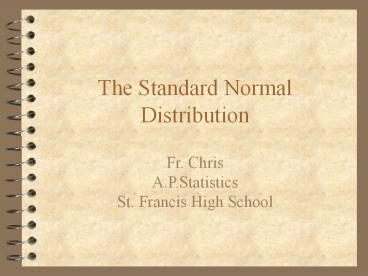The Standard Normal Distribution - PowerPoint PPT Presentation
Title:
The Standard Normal Distribution
Description:
The Standard Normal Distribution Fr. Chris A.P.Statistics St. Francis High School Requirements for Any Probability Distribution The Standard Normal Distribution But ... – PowerPoint PPT presentation
Number of Views:97
Avg rating:3.0/5.0
Title: The Standard Normal Distribution
1
The Standard Normal Distribution
- Fr. Chris A.P.StatisticsSt. Francis High School
2
Requirements for Any Probability Distribution
Always Positive
Total area under the curve must be 1
(Since 1 represents 100)
3
The Standard NormalDistribution
Any value of x will produce a
POSITIVE
result
4
But is the area below equal 1?
5
In other words, does
YES!
6
Lets work it out
7
But there is a problem
Has NO antiderivative!
But Karl Friedrich Gauss figured a tricky way
around this!
8
Let us introduce an I such that
I
So the area under the Standard Normal Curve
would be
9
But lets concentrate on the I
Since x is merely avariable of integration, we
can also express I as
I
I
10
So why not express I2 as
or
11
This double integral is actually the volume
under a 3-D bell
12
Rectangles arent the only thing that integrates!
We can now do a clever change of variableby
converting to
Polar coordinates!
13
How polar coordinates work,and how to make the
switch...
Any integral can be computed by the limit of
Riemann sums over Cartesian rectangles or
Riemann sums over polar rectangles. The area of a
Cartesian rectangle of sides dx and dy is dxdy
but the area of a polar rectangle of sides dr and
dt is NOT just drdt
14
Rather dA is a bit more...
Getting back to our story...
15
Recall the Pythagorean Theorem?
We can now do a clever change of variableby
converting to
Polar coordinates!
16
So now we DO have an antiderivative!
17
We can now start evaluating the integral from
negative to positive infinity
And because of symmetry
18
Almost there!
19
But that wasnt I
...that was I squared!
So
20
Recall the area under the Standard Normal Curve
So
21
So the area under the curve is 1!
Wasnt Professor Gauss clever?
It is no accident that many Mathematicians still
prefer to callthe Standard Normal distribution
The Gaussian Distribution































